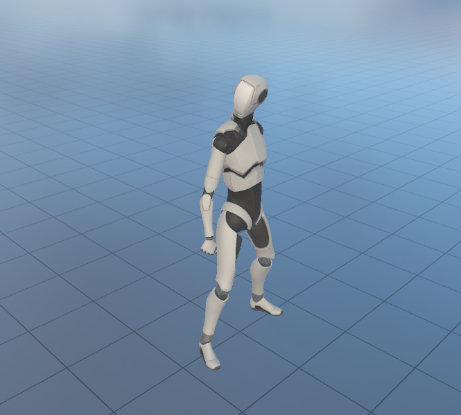As FlexMotion is a PlayableGraph, it is possible to insert custom Animation jobs that will be evaluated alongside the graph.
The job must implement the interface IAnimationJob to be properly converted into an AnimationScriptPlayable.
A Job can be inserted into the graph at two different points:
- At the end of the graph via the dedicated FlexMotionAnimator's method. This will essentially apply the job to the entire animation system as it will be executed after the layer blending.
- At the end of a Motion Layer playable chain via its dedicated method. Using a layer allows the job output to be blended with other motion layers.
Here is a demonstration of these two approaches. For this example, we will create a new component and a job. To keep it simple, the job will just force a joint to always look toward the right. Then we can just instantiate a new job and call the FlexMotionAnimator's InsertAnimationJob method.
The component and the job could be written like so:
using SV.FlexMotion;
using UnityEngine;
using UnityEngine.Animations;
public class InsertAnimationJob : MonoBehaviour
{
[SerializeField]
private AnimationClip clip;
[SerializeField]
private FlexMotionAnimator animator;
[SerializeField]
private Transform joint;
private void Start()
{
var job = new LookRightJob()
{
Joint = animator.MecanimAnimator.BindStreamTransform(joint)
};
animator.InsertAnimationJob(job);
animator.Play(clip);
}
private struct LookRightJob : IAnimationJob
{
public TransformStreamHandle Joint;
public void ProcessRootMotion(AnimationStream stream)
{
}
public void ProcessAnimation(AnimationStream stream)
{
Joint.SetLocalRotation(stream, Quaternion.LookRotation(Vector3.right));
}
}
}
Attaching the component to a character should modify the resulting animation like so:

As mentioned, using the FlexMotionAnimator's InsertAnimationJob method affects every motion layer. Playing another animation will not affect the job output.
It might be the desired result but if you want the job to be applied on a specific layer, you have to use the motion layer's InsertAnimationJob method instead.
Here is an example:
using SV.FlexMotion;
using UnityEngine;
using UnityEngine.Animations;
public class InsertAnimationJob : MonoBehaviour
{
[SerializeField]
private AnimationClip clip;
[SerializeField]
private AnimationClip clip2;
[SerializeField]
private FlexMotionAnimator animator;
[SerializeField]
private Transform joint;
private void Start()
{
var job = new LookRightJob()
{
Joint = animator.MecanimAnimator.BindStreamTransform(joint)
};
var layer1 = animator.Play(clip).OnComplete(this, (x, _) => x.animator.Play(x.clip2));
layer1.InsertAnimationJob(job);
}
private struct LookRightJob : IAnimationJob
{
public TransformStreamHandle Joint;
public void ProcessRootMotion(AnimationStream stream)
{
}
public void ProcessAnimation(AnimationStream stream)
{
Joint.SetLocalRotation(stream, Quaternion.LookRotation(Vector3.right));
}
}
}
With that method, the effect of the job will be smoothly blended into the next animation during a transition like so:
📝 Note
Jobs applied on a layer will be automatically removed once they become inactive and are detached from the graph. Thus, the job needs to be reinserted every time you play the animation requiring it.